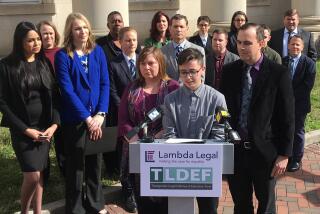In N.C., compensation for forced sterilization will have to wait
- Share via
RALEIGH, N.C. -- Earlier this year, North Carolina became the first state to decide to award a dollar amount -- $50,000 -- to living victims of state-run forced sterilization programs during the early and mid-20th century.
But in a budget deal announced Wednesday, the state Legislature did not provide funding for the compensation. The Republican leadership could not agree on what to pay, if anything, to the estimated 1,300 to 1,800 living victims of the state’s eugenics program, which operated from 1929 to 1974.
The state House had approved the $50,000 payment per victim. But Republicans in the Senate questioned the cost in light of the state’s beleaguered budget and warned that compensation could encourage other groups to seek damages from the state.
State Sen. Phil Berger, the Senate leader, told reporters Wednesday that there was no support for the payments, meaning any payouts would probably have to wait at least until next year’s budget.
House Speaker Thom Tillis, who supports the payments, told reporters: “I think there’s a very strong message from the Senate that they’re not prepared to take it up this year.’’
Tillis said he regarded the inability to fund the compensation program “a personal failure.’’ He added: “It’s something I’ll continue to work on.’’
The effort has the backing of Gov. Bev Perdue, a Democrat. In 2010, Perdue established the Justice for Sterilization Victims Foundation, which recommended the $50,000 payments in January.
More than 7,600 people were sterilized from 1929 to 1974 in North Carolina, which ran one of the country’s most aggressive eugenics programs. A State Eugenics Board attempted to “purify” North Carolina’s population by weeding out the mentally ill, diseased, “feeble-minded” and others deemed undesirable.
In a 1950 pamphlet, the Human Betterment League of North Carolina said the board was protecting “the children of future generations and the community at large,” adding that “you wouldn’t expect a moron to run a train or a feeble-minded woman to teach school.’’
Nearly 85% of those sterilized were women or girls, some as young as 10. Up to 65,000 people in at least 30 states were sterilized nationwide under such programs, according to most estimates. California had the highest number, an estimated 20,000 people.
ALSO:
Zoo’s polar bear escapes, seals ‘washed away’ in Duluth flooding
No piñatas? No confetti eggs? Signs in Houston parks annoy Latinos
ATF image problem? Bring back Eliot Ness -- as building name, at least
More to Read
Sign up for Essential California
The most important California stories and recommendations in your inbox every morning.
You may occasionally receive promotional content from the Los Angeles Times.











